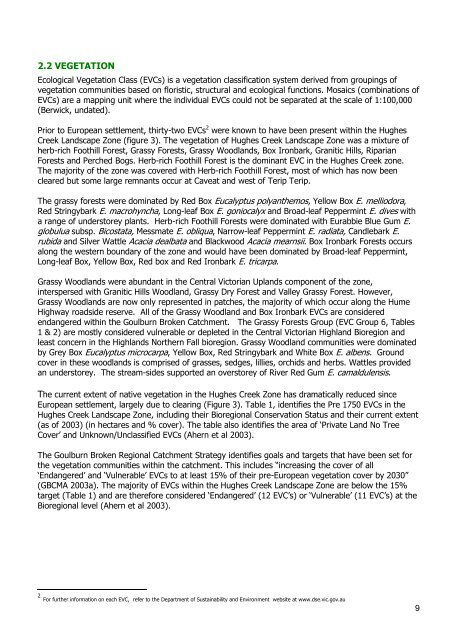Conservation Plan Hughes Creek Landscape Zone - Strathbogie ...
Conservation Plan Hughes Creek Landscape Zone - Strathbogie ...
Conservation Plan Hughes Creek Landscape Zone - Strathbogie ...
You also want an ePaper? Increase the reach of your titles
YUMPU automatically turns print PDFs into web optimized ePapers that Google loves.
2.2 VEGETATION<br />
Ecological Vegetation Class (EVCs) is a vegetation classification system derived from groupings of<br />
vegetation communities based on floristic, structural and ecological functions. Mosaics (combinations of<br />
EVCs) are a mapping unit where the individual EVCs could not be separated at the scale of 1:100,000<br />
(Berwick, undated).<br />
Prior to European settlement, thirty-two EVCs 2 were known to have been present within the <strong>Hughes</strong><br />
<strong>Creek</strong> <strong>Landscape</strong> <strong>Zone</strong> (figure 3). The vegetation of <strong>Hughes</strong> <strong>Creek</strong> <strong>Landscape</strong> <strong>Zone</strong> was a mixture of<br />
herb-rich Foothill Forest, Grassy Forests, Grassy Woodlands, Box Ironbark, Granitic Hills, Riparian<br />
Forests and Perched Bogs. Herb-rich Foothill Forest is the dominant EVC in the <strong>Hughes</strong> <strong>Creek</strong> zone.<br />
The majority of the zone was covered with Herb-rich Foothill Forest, most of which has now been<br />
cleared but some large remnants occur at Caveat and west of Terip Terip.<br />
The grassy forests were dominated by Red Box Eucalyptus polyanthemos, Yellow Box E. melliodora,<br />
Red Stringybark E. macrohyncha, Long-leaf Box E. goniocalyx and Broad-leaf Peppermint E. dives with<br />
a range of understorey plants. Herb-rich Foothill Forests were dominated with Eurabbie Blue Gum E.<br />
globulua subsp. Bicostata, Messmate E. obliqua, Narrow-leaf Peppermint E. radiata, Candlebark E.<br />
rubida and Silver Wattle Acacia dealbata and Blackwood Acacia mearnsii. Box Ironbark Forests occurs<br />
along the western boundary of the zone and would have been dominated by Broad-leaf Peppermint,<br />
Long-leaf Box, Yellow Box, Red box and Red Ironbark E. tricarpa.<br />
Grassy Woodlands were abundant in the Central Victorian Uplands component of the zone,<br />
interspersed with Granitic Hills Woodland, Grassy Dry Forest and Valley Grassy Forest. However,<br />
Grassy Woodlands are now only represented in patches, the majority of which occur along the Hume<br />
Highway roadside reserve. All of the Grassy Woodland and Box Ironbark EVCs are considered<br />
endangered within the Goulburn Broken Catchment. The Grassy Forests Group (EVC Group 6, Tables<br />
1 & 2) are mostly considered vulnerable or depleted in the Central Victorian Highland Bioregion and<br />
least concern in the Highlands Northern Fall bioregion. Grassy Woodland communities were dominated<br />
by Grey Box Eucalyptus microcarpa, Yellow Box, Red Stringybark and White Box E. albens. Ground<br />
cover in these woodlands is comprised of grasses, sedges, lillies, orchids and herbs. Wattles provided<br />
an understorey. The stream-sides supported an overstorey of River Red Gum E. camaldulensis.<br />
The current extent of native vegetation in the <strong>Hughes</strong> <strong>Creek</strong> <strong>Zone</strong> has dramatically reduced since<br />
European settlement, largely due to clearing (Figure 3). Table 1, identifies the Pre 1750 EVCs in the<br />
<strong>Hughes</strong> <strong>Creek</strong> <strong>Landscape</strong> <strong>Zone</strong>, including their Bioregional <strong>Conservation</strong> Status and their current extent<br />
<br />
<br />
The Goulburn Broken Regional Catchment Strategy identifies goals and targets that have been set for<br />
the vegetation communities within the catchment. <br />
-Europea<br />
(GBCMA 2003a). The majority of EVCs within the <strong>Hughes</strong> <strong>Creek</strong> <strong>Landscape</strong> <strong>Zone</strong> are below the 15%<br />
<br />
Bioregional level (Ahern et al 2003).<br />
2 For further information on each EVC, refer to the Department of Sustainability and Environment website at www.dse.vic.gov.au<br />
9


